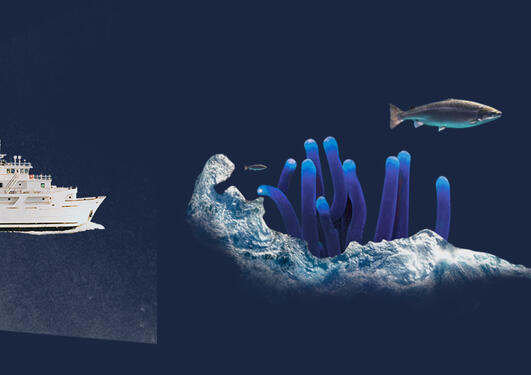Research possibilities for the SEAS postdoctoral research fellow in ocean observation technology
The information on this page is a supplement to the complete advertisement of the position in the recruitment-portal Jobbnorge. The full advertisement of this position in Jobbnorge will be available after august 1, and linked from this webpage. Call deadline is October 31, 2021.
Main content
Position | SEAS postdoctoral research fellow at Department of Earth Science |
Research area | Ocean observation technology |
Supervisor-team | Professor Rolf Birger Pedersen and Researcher Thibaut Barreyre |
Mobility | For an incoming candidate |
Unit of employment | Department of Earth Sciences at University of Bergen |
Group affiliation(s) | The Centre for Deep Sea Research/Geochemistry and Geobiology Research Group/The Norwegian Ocean Laboratory |
Thematic area and supervisors
This position is connected to the Arctic spreading ridges, with a main focus on the volcanic activity, and associated hydrothermal activity and the use of ocean observatory technology to study these systems. The position is open to an incoming candidate, see mobility rules. The successful candidate will be employed at the Department of Earth Science and included in the Centre for Deep Sea Research. Information about the supervisors, research groups and research possibilities for the fellow is available below. For further details about the research possibilities please contact Professor Rolf Birger Pedersen.
Research possibilities and resources
Supervisors: Rolf B. Pedersen has been Professor in Geology at the Dept. of Earth Science, University of Bergen (UiB) since 1994. He has been leading a Centre of Excellence in geobiology, and he is currently the leader of a Centre for Deep Sea Research that is focusing on spreading ridges and hydrothermal systems. He has been working on a range of aspect related to the formation of oceanic lithosphere. This has been based on the study on ophiolite complexes, and on deep-sea expeditions using submersibles, underwater robotics and ocean drilling vessels. The research has been focused on the magmatic and volcanic processes that form the seafloor, the study of deep-sea hydrothermal systems and seafloor mineral deposits - and on interactions between the geosphere and the biosphere. To support the ongoing deep sea research initiative, he has established a national ROV-facility as well as geochemistry laboratories. He is also leading the Norwegian Ocean Laboratory that is housing a range of national ocean observation systems. Pedersen has been principal investigator (PI) on 30 national and international ocean-going research cruises, he has supervised or co-supervised 50 MSc and 18 PhD students, and has published more than 130 international publications.
Thibaut Barreyre is a junior research scientist in marine geophysics at the department of Earth Science, University of Bergen, and an adjunct scientist at the department of Geology and Geophysics (G&G) at the Woods Hole Oceanographic Institution (WHOI). He is also associated with the Centre for Deep Sea Research, leading the theme on Innovation and Technology, and the Norwegian Ocean Observation Laboratory. His research focuses on the interplay between fluid flow and geological and oceanographic processes in porous media using a combination of observational work, data analysis, and modeling. He has participated in 12+ international expeditions to these systems worldwide (9+ as geophysics team leader), developing a professional network of US and EU mid-ocean ridge researchers perfect for nurturing the postdoctoral student early career connections. He is currently leading the international InterRidge working group on deep-sea observatories. As a successful follow-up of this observatory effort, he is one of the PIs of a recent Infrastructure grant from the Research Council of Norway to establish the Norwegian node of EMSO in which he leads the EMSO-Mohn Observatory work-package.
Research groups/Centers: The supervisors have an established cooperation with the research groups and centers at the University of Bergen that are listed below.
- The candidate will be a member of the Centre for Deep Sea Research (https://www.uib.no/en/deepsea). The Centre is integrating marine geosciences and biosciences in a joint effort to address a range of basic science questions related to deep-sea processes, resources and environment. The Centre is responsible for major national ocean observation systems. The Centre provides professional support and advice to industry, authorities and the society on deep-sea resources and environments.
- The candidate will be affiliated to the Geochemistry and Geobiology Research Group at the Department of Earth Science (https://www.uib.no/fg/geobio)
- The candidate will be affiliated with the Norwegian Ocean Laboratory that is housing a range of ocean observatory systems and that is in the center of a hub of ocean technology and innovation companies.
The choice of co-supervisor from another department (or national research/company partners) than the postdocs host department will be selected dependent on the submitted project profile.
National co-operation partners: A co-operation with Norwegian Defense Research Establishment (FFI) on AUV systems has been ongoing for more than 10 years. Collaboration on seafloor observatory systems and technology involves the partners of the NOR-EMSO observatory (UiB, IMR, UiT, NORCE). In this project UiB and Centre for Deep Sea Research leads the establishment of an observatory system at the Mohns Ridge. It also involves the six research partners of the LoVe-coastal observatory, where large industrial companies like Equinor are involved.
International co-operation partners: Depending on the focus of the submitted postdoctoral project, the international research and/or university partners hosting the candidate could be at the Ifremer, University of Kiel/GEOMAR, University of Bremen (MARUM), University of Southampton.
See the full advertisement in Jobbnorge
The full advertisement in Jobbnorge will be available after august 1, 2021. Call deadline is October 31, 2021. This is unpublished now, but a pdf can be found here.
